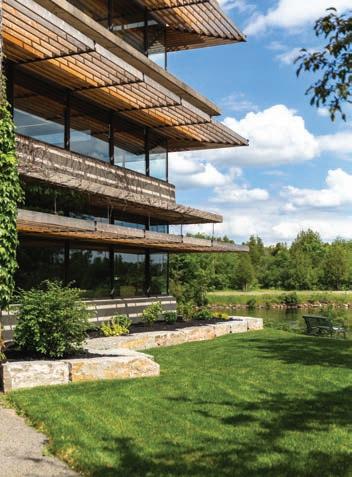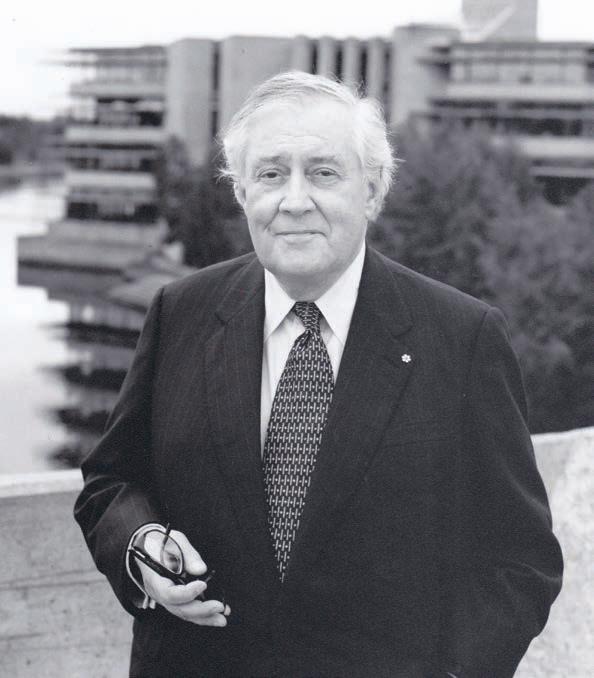
18 minute read
The Orillia Centre: Lending a Home to Artists
Lending a Home to Artists

when Housing becomes Out of Reach
MICHAEL MARTYN ’90, general manager of the Huronia Cultural Campus
The Orillia Centre for Arts + Culture (OCA+C ) is a bold vision that comes at a critical time for Canada’s cultural sector. Between radical changes to established arts business models, and skyrocketing costs of living, especially in major centres where most artists live and work, professional culture makers in Canada have never faced more significant economic challenges. Both their ability to earn income and the costs of practice are shifting quickly, and not in their favour. The capacity of artists and arts organizations across multiple disciplines to create significant new works is fundamentally threatened; by extension, so is the culture of our country.
What is needed, and something OCA+C is positioning itself to be, is a place, near to Canada’s largest population base, purposefully designed to act as a self-sustaining, autonomous year-round centre for creation, innovation, and cultural expression. The volatility of government arts funding requires that such a place self-generate 60% of its own revenue. Sustainability, therefore, requires it be mindful of the ongoing needs and challenges of the Canadian businesses who will invest in keeping it going because there is demonstrated purpose and relevance to doing so. Artists, well accustomed to dealing with scarcity, are the original lean thinkers. As you will see, business has much to learn from the arts—and many common goals can be met through the establishment of a centre where Canada comes to create.
Canada boasts neither the population density/massive market forces that drive pop cultures of the United States, China, India, Japan, among others, nor the comparatively generous European funding models which more actively foster development of new and innovative work. As a result many of the best and most innovative young Canadian artists leave our country, not just to pursue fame, but because Canada lacks the capacity to support the creation of the work they want to make. From Seth Rogen or Shawn Mendes, to Crystal Pite and Attila Richard Lukacs, we are all familiar with stories of Canadians whose success is defined by their rise to prominence outside of Canada.
My own perspective on this issue is a lifetime in the making. In the early 1970s, Professor Tom Symons, then Trent president, hired my father on a contract with the University to research the status of Canadian literature curricula in Canada. A high school English teacher by trade and a cultural nationalist at heart, he and his work led to a number of unique experiences that informed my values and my work for decades. Before I was eight years old, I had travelled across Canada, been to the homes of some of the most important authors in our country, and


developed a profound understanding that the work of culture, and the act of communicating stories, is central to who we are as a geographically vast, demographically dispersed nation.
When discussing the state of arts and culture in Canada, there is temptation to engage in finger pointing at various governments, policies, and agencies—past and present—for not doing enough. But this is reductive. The economics are stacked against artists and there is a current threat to our country’s ability to grow in ways not measured by balance sheets. Central to this is the fact that artists, particularly performing artists, congregate in major cities, where the real estate boom is pricing these very artists out.
If Canadian culture is to thrive, then artists in Canada need places where they can create and realize their vision. The Banff Centre for Arts and Creativity in Alberta, for example, provides studio spaces, residencies, training labs, and much more, across all artistic disciplines. Artists gain access to the centre through application processes and fundraising to pay their fees, most often through grants from one or more arts councils or foundations. Now in its 85th year, Banff Centre is one of the most prestigious and best-known places in the country for artists to engage in short-term study, residencies, and intensives. It’s an incredible place and a rite of passage for many culture makers, both from across Canada and abroad.
Geography and demographics come into play: Banff is far away from the part of the country where most people, and most artists, live and work. The population of the country has almost doubled in the last 50 years, during which time our cultural landscape has undergone profound shifts. There is room in our country for another such place and it makes financial sense for it to be proximate to the population centres.
The challenge of individual creative production, such as writing a new book, recording a collection of songs, creating a new piece of visual art, etc., are constants for individual artists. Balancing the creative process with the requirements of day-today living often requires external resources—often in the form of sponsorship and patronage, family money, or one or more day jobs— balanced with a frugal life style. These challenges grow exponentially as the scope of the work increases. As more skill sets are required, and the number of collaborators and workers increases, there are more people to pay, schedules to arrange, hours of meeting/rehearsal time to be had, and more. This is an undertaking that requires significant resources, well outside the financial and organizational scope of virtually any individual artist. The foundation of much of our public policy for arts and culture (as we know it) lies in the Massey Commission (1949-51). While it is rightfully critiqued from a contemporary perspective, the document still holds relevance today. Zainub Verjee, citing Joyce Zemans, observed that the Cold War context within which the Massey Report was written, led to art in Canada “[becoming] valued mainly in terms of nationalism and encouraging a single ‘national identity’ rather than other values.” Neither Canada, nor the world in which we live, are the same. Other legislation, royal commissions, and studies have sought to secure the place of the nation’s culture makers in the face of unprecedented technological change and population shifts within a primarily nationalist context. Canadian trade policy has been emulated around the world by nations looking to secure their own identity in the face of business-driven forces of cultural hegemony. UNESCO looks to the cultural exemptions in our free trade agreements with the United States as best practice.
Even before Massey, the consistent theme was that Canadian culture was vulnerable to market forces, especially from the United States. The Aird Report (1929), which led to the founding of the CBC, recommended a national public broadcaster capable of “fostering a national spirit and interpreting national citizenship.” The report itself was largely predicated on the need to satisfy Canadian broadcast business interests and to establish and protect national markets threatened by crossborder broadcast signals. Since the 1970s, the Canadian cultural sector has navigated, by both design and accident, massive change in national and global economic and political landscapes.
Contemporary policy around streaming, data, creation quotas, and much else has similarly been in response to rapid technological and market changes. There is a sense at the policy level of closing the doors after the horse has left the barn. If, as Trent



University chancellor emeritus, Dr. Don Tapscott ’66 says in Blockchain Revolution, creative industries are “the bellwethers of our economy … reveal[ing] faster than nearly any other industry how both producers and consumers will adopt and then adapt a technology to their lives,” then the economic argument to support artists in their creative process becomes more widely relevant. This notion that artists are the canaries in the economic coal mine is not new, but 20 years post-Napster ought to have made the urgency obvious.
According to the 2016 Census the median average individual wage in Canada was $41,900. Among artists, across all disciplines, the median is only $23,100. The same data shows 183,200 Canadians make their living as artists. For comparison, automotive manufacturing employ 154,100, and utilities employ 144,900. Market imbalances and the law of supply and demand certainly enter into the equation, but the numbers demonstrate a changing reality in our national economic picture.
We have never seen the arts as integral to the economy in the same way that manufacturing or natural resources are, but what if we did? By sheer numbers alone, we see the degree to which the arts are shaping the economy of the future. We need to acknowledge, as a country, the role that arts and culture has in a changing macro-economic environment. If the priority of our cultural policy is to instill a strong sense of nationalism, both within Canada and abroad, through export, then the standard of living for artists is a significant consideration. To pick up on Dr. Tapscott’s point, if we view the ways that artists innovate to support their livelihoods as a bellwether of what lies in store for the economy as a whole, we gain insight into how Canada, as a nation, can build long-term strategies for economic sustainability and meaningful employment. As economies change and we move ever further from being drawers of water and hewers of wood, innovation will continue to accelerate. In this context, the arts become a strategy lab for research and development of economic sustainability.
Building the place where Canada comes to create requires multiple partners, strong leadership, strategic thinking, and tenacity. Originally the vision of painter Charles Pachter, the concept has grown to include a broad range of stakeholders and concepts. At the moment the Orillia Centre is primarily a programming organization offering critically challenging and non-commercial presentations to our audiences in the Orillia/Rama/Midland area. The next step is to establish ourselves as one of the foremost cultural creative centres in central Canada, with a physical presence to focus on a wide range of arts education and the development of original artistic works. We receive funding from four levels of government and a range of corporate and private donors, notably TD Community Grants. The diversity of the programming reflects the scale of the project being undertaken.
upcoming events
June 19
Ottawa Trent Rugby Booster Club Ottawa Gathering
July 12 – July 14
Peterborough 30 Years and Counting –International Reunion at Trent
October 4 – October 6
50th Anniversary Head of the Trent Regatta
For our full events listing, please visit: mycommunity. trentu.ca/events

BENEFITS & SERVICES
For a full list please visit: mycommunity.trentu.ca/alumni For alumni news and updates, including podcast interviews, longform journalism pieces, and previous editions of TRENT Magazine, please visit: trentmagazine.ca
FOLLOW US ONLINE!
@TrentAlumni @trent_alumni Trent University Alumni Association
The Official Trent University Alumni (Group)
We’d love to hear from you!
Have questions or comments about what you read in TRENT Magazine?
Email managing editor Donald Fraser at donaldgfraser@trentu.ca
THE CAMPAIGN FOR TRENT DURHAM GTA
Trent University was founded on the ideal of collaborative learning that brings critical, integrative thinking to life every day. In addition to Peterborough, Trent has been an integral part of the Durham community for more than 44 years, with a steadfast commitment to providing access to a university education for students in the region.
We began by offering night school courses at Eastdale Collegiate to mature and part-time students, including those working at industrial and manufacturing organizations. Fast-forward more than four decades, and Trent University Durham welcomed our largest incoming class in 2018/19. With 70% of Trent Durham students from the Durham region, we are truly the region’s university. As we embark on our
OUR GOAL next chapter, the $5 million campaign for Trent University $5 MILLION Durham GTA will support the campus expansion project, increase financial aid for students, and provide students with hands-on experiences and careerready skills.

TOGETHER, LET’S BUILD SOMETHING TRANSFORMATIVE
The Durham campus is growing— from our current 1,400 students, to a projected enrollment of 2,250 by 2024 with a long-term plan to grow the campus to 2,500 students. But with growth comes challenges—one of which is residence space. To allow more students the opportunity to join the Trent community, we are planning a new six-storey multi-use space that will be a welcoming new gateway to the Durham campus.
Integrating a 200-bed residence, a 100-seat tiered lecture hall, two 64-seat classrooms, research space, student common spaces, and faculty offices, this building will be a vibrant learning community built on the college system for which Trent is known.
Opening in fall 2020, this new $30+ million building will be funded through a private partnership, university financing and philanthropic support from our community, friends, and alumni.
“Growing Trent’s Durham Campus is a wonderful opportunity for Trent and for Durham. For more than 40 years, Trent has provided key educational opportunities for our students in the region. Our new building will accommodate a dramatic increase in enrolment in a way that allows our campus to flourish. Coupled with the development of our post-secondary partners in Durham, the expansion of our campus will help make Durham a major player in post-secondary education in the province.”
DR. LEO GROARKE, President and vice-chancellor Trent University
LET’S GIVE STUDENTS THE SUPPORT THEY NEED TO SUCCEED
Trent University is recognized as a leader in providing scholarships and bursaries, in part due to the generous support of our donors. However, there are few scholarships and bursaries specifically awarded to Trent Durham students.
With your help, we can create 30 new funds to bolster student support so that financial strain does not become a barrier for students with the drive, curiosity, and creativity to make a difference in our world.
https://mycommunity.trentu.ca/ durhamcampaign
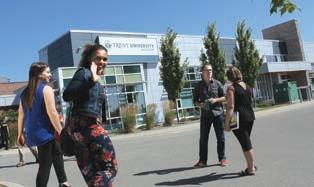
LET’S DEVELOP SKILLED LEADERS AND GLOBAL THINKERS
Experiential learning is not only a critical component of a modern education but a hallmark of a Trent education. Internships and study abroad opportunities will open worlds to Trent students, as they learn that truly, not all classrooms have four walls. Educating students with both a local and global perspective enables them to develop career-ready skills that they can use to help shape their own communities. Internships expose students to new career interests, help develop job skills, expand professional networks, and deepen understanding of their community. In turn, they also increase the capacity of the local agencies to meet the needs of the community they serve.
With your help, we can raise $500,000 to increase experiential learning opportunities for Trent Durham students, to hone the skills and broaden the minds of our growing student community.

JOIN US!
To help ensure TRENT UNIVERSITY DURHAM GTA continues to be a vibrant institution of collaboration, discovery and leadership.
DOUG KIRK ’70 Co-chair, Trent Durham GTA Campaign Executive President, Durham Radio Inc. “I am thrilled to be involved in the Campaign for Trent Durham GTA. I am deeply invested in this growing community, and believe Trent is a significant partner in providing a vibrant future for our children.”
STEVE APOSTOLOPOULOS Co-chair, Trent Durham GTA Campaign Executive Managing partner, Triple Group of Companies
To kick-off the campaign, Durham Radio President Doug Kirk ’70 generously donated $500,000 in support of the Durham campus expansion and hopes that his gift will inspire other alumni to give. To learn more about the Campaign for Trent University Durham GTA and how you can help, visit trentu.ca/givetrentdurham
HONOURING THE MICHI SAAGIIG
Trent University’s campuses are located on the treaty and traditional territory of the Michi Saagiig, or the Mississauga Anishnaabeg people. Mirroring the University’s leadership in Indigenous Studies, Trent is committed to institutional actions that advance reconciliation and respect and honour the traditional people of these lands which includes Curve Lake First Nation, Hiawatha First Nation, Alderville First Nation, and Mississaugas of Scugog Island First Nation.
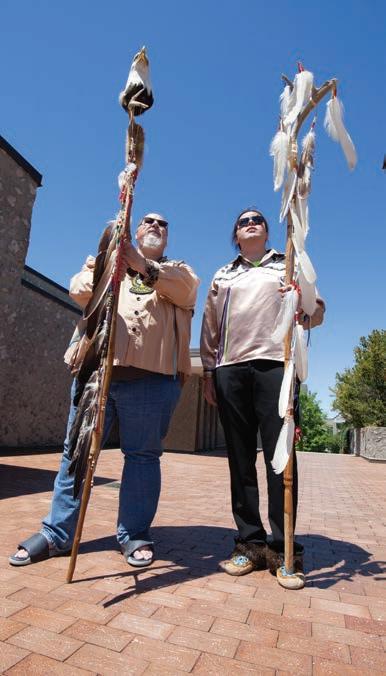
In 2018 Trent formed the Elders & Traditional Knowledge Keepers Council to advise on actions that include naming of campus spaces in Anishinaabemowin, use of a land acknowledgement at public events, an annual Provost’s lecture on reconciliation, an orientation module about the Michi Saagiig for new staff and faculty, and online resources to support students, staff, and faculty as they embark on personal journeys of reconciliation.
A land acknowledgement recognizes the traditional lands of Indigenous peoples and is an appropriate way to show respect to Indigenous people of Share your ideas as we update the region, their ancestors, and communities. the Trent Nature Areas Plan.TRENT UNIVERSITY’S OFFICIAL LAND ACKNOWLEDGEMENT: We respectfully acknowledge that we are on the treaty and traditional territory of the Mississauga Anishnaabeg. We offer our gratitude to the First Nations for their care for, and teachings about, our earth and our relations. May we honour those teachings. The Trent Lands and Nature Areas Plan will assist the University to achieve its vision of a ‘sustainable and inspiring campus community, thoughtfully integrating the natural and built environment, with vibrant spaces to learn, innovate, be active and live.’ Phase 1 of this two-phase initiative is focused on understanding and mapping the natural, cultural and archaeological features and functions existing within the campus lands, such as the location, type and status of wetlands and woodlands, species, and areas of significance to First Nations. Phase 1, happening now, will review the Nature Areas Stewardship Plan, mapping natural heritage features and functions on the campus to identify areas for protection, stewardship, remediation and enhancement. Share your ideas as we update Get involved at trentlands.ca the Trent Nature Areas Plan. The Trent Lands and Nature Areas Plan will assist the University to achieve its vision of a ‘sustainable and inspiring Social PinPoint: Share ideas about Trent's campus right from your campus community, thoughtfully smartphone. Drop a pin on your favourite places, areas for enhancements, and significant natural or cultural features. The Trent Lands and Nature Areas Plan will assist the University to achieve its vision of a integrating the natural and built ‘sustainable and inspiring campus community, thoughtfully integrating the natural and built environment, with vibrant spaces to iNaturalist: Share your nature sightings to help our understanding of the environment, with vibrant spaces to learn, innovate, be active and live.’ learn, innovate, be active and live.’ Phase 1 of this two-phase initiative is biological diversity at Trent. Phase 1 of this two-phase initiative is focused on understanding and mapping the natural, cultural focused on understanding and mapping Send your ideas for Trent's Nature Areas to trentlandsplan@trentu.ca. and archaeological features and functions existing within the campus lands, such as the location, type and status of wetlands and woodlands, species, and areas of significance to First Nations. the natural, cultural and archaeological features and functions existing within the campus lands, such as the location, type and status of wetlands and woodlands, Phase 1, happening now, will review the Nature Areas Stewardship Plan, mapping natural heritage species, and areas of significance to features and functions on the campus to identify areas for protection, stewardship, remediation First Nations. and enhancement.
SHARE YOUR IDEAS Phase 1, happening now, will review the Nature Areas Stewardship Plan, mapping natural heritage features and functions on the campus to identify areas for protection, stewardship, remediation and enhancement. Get involved at trentlands.ca
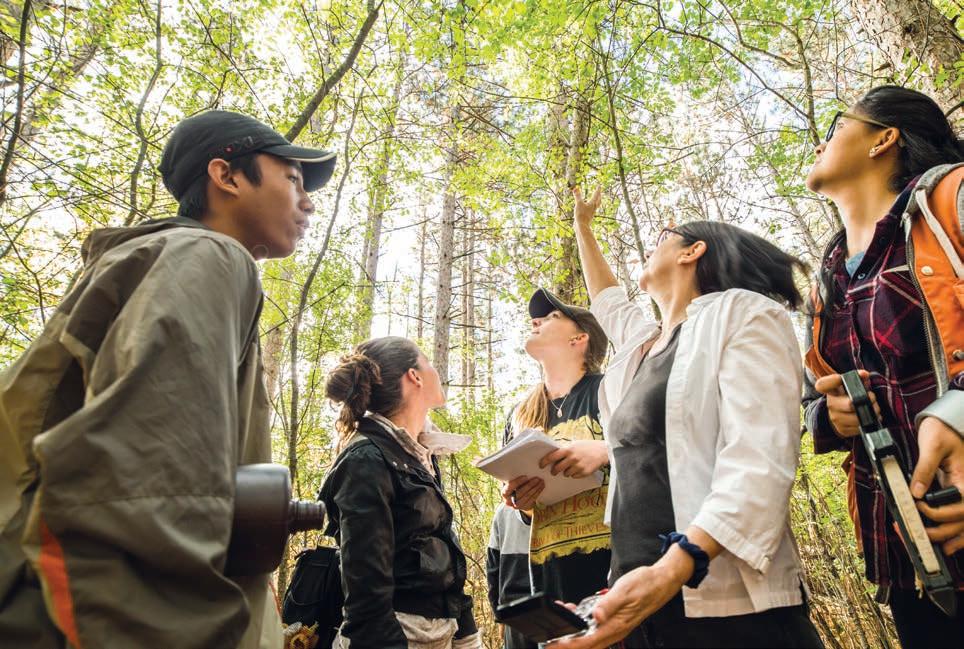
CONTRIBUTORS
MICHAEL MARTYN ’90
Originally from Peterborough, Ontario, Michael Martyn has worked in the cultural sector for almost 30 years, including time in Banff, Vancouver, and Melbourne, Australia. Currently based in Orillia, Ontario, Mr. Martyn serves as general manager of the Huronia Cultural Campus. With an M.B.A. from Schulich School of Business, he is committed to developing long term career prospects for cultural sector workers who live in regional and rural areas.
Mr. Martyn volunteers as a member of the National Steering Committee for SPARC Network, and serves as board secretary for Information Orillia, as well as contributing time to a number of not for profit organizations in the culture and social sectors.
Outside of his administration work Michael works as a live performance technician and performing singer/ songwriter. His third solo album, Rude Mechanicals, was released in October 2018.
IAN TAMBLYN ’69
Ian Tamblyn’s bio can be found on page 37.
SHIRLEY WILLIAMS ’79
Shirley Williams is a member of the Bird Clan of the Ojibway and Odawa First Nations of Canada. Her Anishinaabe name is Migizi ow Kwe meaning Eagle Woman. She was born and raised at Wikwemikong, Manitoulin Island and attended St. Joseph’s Residential School in Spanish, Ontario. After completing her NS diploma, she received her B.A. in Native Studies at Trent University and her Native Language Instructors Program diploma from Lakehead University in Thunder Bay. Ms. Williams received her master’s degree from York University in Environmental Studies. In June of 2004, Shirley retired from the Indigenous Studies Department and now holds the title professor emeritus.
CHEYENNE WOOD
Cheyenne Wood is a second-year student in the Foundations of Indigenous Learning Program at Trent. Actively involved on the Trent Symons Campus, Ms. Wood has held positions including Firekeeper for the First People’s House of Learning, as well as staff writer for the student-run newspaper, Arthur.
IN MEMORIAM
Fondly remembering those who passed this year.
Richard Cameron, former faculty (William) David Cummings ’68 Paul Dewar ’80 Sandra Macfarlane ’90 Harold McKee ’79 John Muir ’75 Veronica O’Reilly ’65 (Elizabeth) Betty O’Toole, retired employee Margery Peck Upton ’80 Peter Watson, retired faculty
